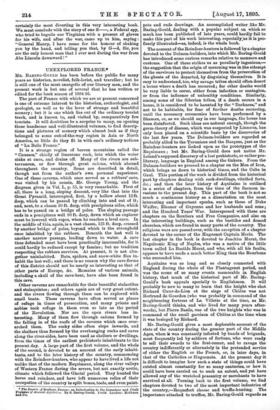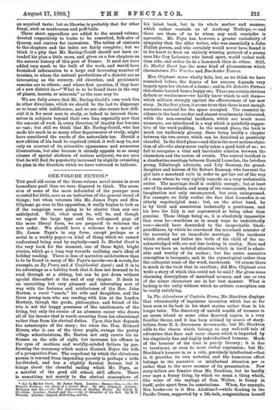UNEXPLORED FRANCE.*
MR. BARING-GOULD has been before the public for many years as historian, novelist, folk-lorist, and traveller; but he is still one of the most energetic of our literary men, and the present work is but one of several that he has written or edited for the book season of 1894 95.
The part of France with which we are at present concerned is one of extreme interest to the historian, archmologist, and geologist, as well as to the lover of strange and beautiful scenery ; but it is one which lies out of the ordinary tourist track, and is known to, and visited by, comparatively few tourists. It will doubtless be a surprise to many, on opening these handsome and well-illustrated volumes, to find descrip- tions and pictures of scenery which almost look as if they belonged to some out-of-the-way region in Asia or North America, so little do they fit in with one's ordinary notions of "La Belle France."
It is a strange region of barren mountains called the " Oausses," chiefly of limestone rock, into which the water sinks at once, and drains off. Many of the rivers are sub- terranean, or flow through great canons, which abound throughout the country. Some are described in detail, though not from the author's own personal experience. One of these caverns, which once served as a robbers' cave, was visited by his cousin, Mr. George Young, and the diagram given in VoL I., p. 55, is very remarkable. First of all, there is a long, sloping descent, very like that into the Great Pyramid, interrupted, first, by a hollow about 12 ft. deep, which can be passed by climbing into and out of it; and, next, to a chasm 50 ft. deep, with precipitous sides, which has to be passed on a bridge of poles. The sloping passage ends in a precipitous well 90 ft. deep, down which an explorer must be lowered with ropes, when he reaches a level cave. In the middle of this, again, is a vast chasm, 125 ft. deep, crossed by another bridge of poles, beyond which is the stronghold once inhabited by the robbers. Beneath the last well is another narrow passage, leading down to water. A cave thus defended must have been practically inaccessible, for it could hardly be reduced except by famine ; but no tradition respecting the robbers survives. At present, it is not alto. gether uninhabited. Bats, spiders, and snow-white flies in- habit the last well ; and there is no reason why the cave-forms of this district should not be nearly as interesting as that of other parts of Europe, &c. Remains of various animals, including a skull of the cave-bear, have also been found in this cave.
Other caverns are remarkable for their beautiful stalactites and stalaquintes ; and others again are of very great extent, and the rivers flowing through them can be explored with small boats. These caverns have often served as places of refuge in times of persecution, and many priests and nobles took refuge in them even so late as the period of the Revolution. Nor are the open rivers less in- teresting. Many of them flow through canons formed by the falling in of the roofs of the caverns which once over- arched them. The rocky sides often slope inwards, and the shelters thus formed by the overhanging rocks and caves along the river-sides, have been used as shelters or dwellings, from the times of the earliest prehistoric inhabitants to the present day. A large part of the first volume, and the whole of the second, is devoted to an account of the early inhabi- tants, and to the later history of the country, commencing with the Reindeer-hunters, who appear to have lived a life not unlike that of the modern Esquimaux, along the river valleys of Western France during the severe, but not exactly arctic, climate which followed the Glacial period. They hunted the horse and reindeer, and have left numerous relics of their occupation of country in split bones, tools, and even paint-
• The Deserts of Southern Franco: an Introduction to the Limestone and Chalk Plateaux of Ancient Aquitaine. By B. Baring-Gould. 2 vole. London: 3Iethnon aud O o.
pots and rude drawings. An accomplished writer like Mr. Baring-Gould, dealing with a popular subject on which so much has been published of late years, could hardly fail to make this part of his work interesting, especially:as it is pro- fusely illustrated—as, indeed, is the whole book.
The account of the Reindeer-hunters is followed by a chapter devoted to the Dolmen-builders, into which Mr. Baring-Gould has introduced some curious remarks relative to manners and customs. One of these strikes us as peculiarly ingenious,— the suggestion that the origin of mourning was in the attempt of the survivors to protect themselves from the persecution of the ghosts of the departed, by disguising themselves. It is easy to understand, too, why savage tribes should often desert a house where a death has occurred ; for other deaths would be very liable to occur, either from infection or contagion, or from the influence of unhealthy conditions. Similarly, among some of the Siberian tribes, if a death occurs in a house, it is considered to be haunted by the "Darkness," and not to be habitable, for fear of further deaths occurring, until the necessary ceremonies have been performed by a Shaman, or, as we should say in our language, the house has been disinfected. Such ideas are natural enough, though the germ-theory of disease, which was suspected by Linnmus, has only been placed on a scientific basis by the discoveries of the last few years. The Dolmen-builders are regarded as probably allied to the Turanians and the Basques, just as the Reindeer.hunters are looked upon as the prototypes of the Esquimaux ; but Mr. Baring-Gould does not notice Mr. Leland's supposed discovery of a lost prehistoric, or rather pre- literary, language in England among the tinkers. From the Dolmen-builders we proceed to a chapter on the Men of Iron, which brings us down to historical times, and the Celts in Gaul. This portion of the work is divided from the historical part by chapters dealing with rock-dwellings, vitrified forts, &c.; and then the later history of Aquitaine is outlined in a series of chapters, from the time of the Saracen in- vasions to the present day. This part of the book is not so much a continuous history as a dissertation on the most interesting and important epochs, such as those of Duke Waif re ; Eleanor of Guyenne and her husbands and sons ; and the Hundred Years' War. Interspersed with these are chapters on the Rontiers and Free Companies, and also on the interesting buildings, such as the bastides and domed churches, which are found in many parts of the country. The religious wars are passed over, with the exception of a chapter devoted to the career of the Huguenot Captain Merle. The last chapter in the book is devoted to Joachim Murat, the Napoleonic King of Naples, who was a native of the little town called La Bastide Murat, and who, with all his faults, appears to have made a much better King than the Bourbons who succeeded him.
Aquitaine was so long and so closely connected with England during the whole of the Plantagenet period, and was the scene of so many events memorable in English history, that much of the historical part of Mr. Baring- Gould's book appeals specially to Englishmen. It will probably be new to many to learn that the knight who shot Richard Cmur-de-Lion at the siege of MMus was not Bertrand de Gourdon (who was probably in command of the neighbouring fortress of La Villette at the time, as Mr. Baring-Gould thinks, and who lived for many years after- wards), but Pierre Basile, one of the two knights who was in command of the small garrison of Chillus at the time when it was besieged by Richard.
Mr. Baring-Gould gives a most deplorable account of the state of the country during the greater part of the Middle Ages, when it was constantly infested by bands of brigands, most frequently led by soldiers of fortune, who were ready to sell their swords to the first.comer, and to ravage the country indifferently or alternately in the pretended service of either the English or the French, or, in later days, in that of the Catholics or Huguenots. At the present day it is difficult to imagine how such a state of things could have existed almost constantly for so many centuries, or how it could have been carried on to such an extent, and yet have allowed any of the wretched peasantry or merchants to have survived at all. Turning back to the first volume, we find chapters devoted to two of the most important industries of the country,—Roquefort cheese and truffie-hunting. The importance attached to truffles, Mr. Baring-Gould regards as an acquired taste; but so likewise is probably that for other fungi, such as mushrooms and puff-balls.
Three short appendices are added to the second volume, devoted respectively to books to be consulted, folk-airs of Quercy, and centres for excursions. The tables of contents to the chapters and the index are fairly complete ; but we think it a pity that Mr. Baring-Gould should not have ex- tended his plan a little more, and given us a few chapters on the natural history of this part of France. It need not have added very much to the bulk of the work, and would have furnished information to a large and increasing number of tourists, to whom the natural productions of a district are as interesting as the scenery, old churches, and prehistoric remains are to others ; and whose first question, if they hear of a new district is,—" What is to be found there in the way of plants, insects, or minerals," as the case may be.
We are fully aware that Mr. Baring-Gould's own work lies in other directions, which we should be the last to disparage or to treat with indifference, and we are also aware how diffi- cult it is for most men to study, or indeed to interest them- selves in subjects beyond their own line, especially now that the amount of work in every direction'of inquiry has become so vast ; but still we think that Mr. Baring-Gould, who has made his mark in so many other departments of study, might have considered the needs of the naturalists too. Should a new edition of his book be required (which it well may be, not only on account of its attractive appearance and numerous illustrations, but also because it already appeals to so many classes of special students of various subjects), we are sure that he will find its popularity increased by slightly extending its plan in the direction which we have ventured to indicate.



































 Previous page
Previous page